Last updated on
Zebrafish: A Surprising Partner in the Fight Against Blood Clots
Updated November 2019
Who would have thought that a tiny fish could change how healthcare providers study human health?
Meet the zebrafish.
This small fish serves as an important tool in scientific research. Believe it or not, it has become a big player in the fight against blood clots.
What are zebrafish?
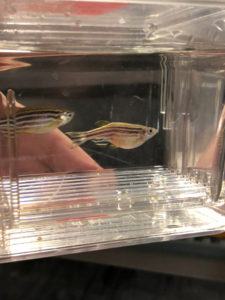
Zebrafish are small freshwater fish that belong to the minnow family. These important little fish originate from the Himalayan region, but can be found in household aquariums across the United States.
Zebrafish were first used in scientific research in the 1970s. Today, they are used in laboratories to research a wide range of topics because they can be used to model biological systems, such as the human body. Their genome, or complete set of genetic material, has been fully sequenced and is well understood. They also reproduce quickly, allowing for multiple generations to be observed in a short time span.
At Brigham and Women’s Hospital in Boston, these fish play an important role in groundbreaking research. They are used in research done by oncologists, developmental biologists, cardiologists, and more.

“We have hundreds, maybe thousands, of tanks here and each tank can hold 15-20 fish,” said Dr. Aaron Kithcart, explaining the capacity of Brigham and Women’s zebrafish lab. Dr. Kithcart is a vascular medicine specialist who carries out research with these fish at Brigham and Women’s Hospital. “We have tens of thousands of adult zebrafish.”
Dr. Kithcart uses the zebrafish to study cardiovascular health and acknowledges that it may surprise people to learn that a small fish can be used to carry out research related to the human body.
“You might notice a big difference between a fish heart and a human heart. One of the big differences is that the zebrafish heart only has two chambers. It has one ventricle and one atrium. Humans have four. But, there are a lot of similarities,” explained Dr. Kithcart. “The electrical conduction in the heart is very similar to that in a human, so we can study arrhythmias, like atrial fibrillation.”
“The vascular system is also similar,” he continued. “They have an aorta, just like us. They also have a vein. We can study things like atherosclerosis and deep vein thrombosis. In the case of a fish, they don’t have limbs, but they have major veins in the tail, so we can study blood clots in the veins.”
Life in the lab
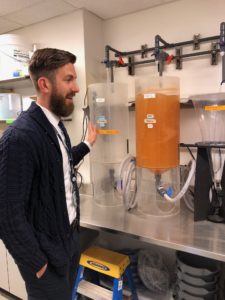
In the lab, the zebrafish are raised in nursery tanks to start their lives and then are moved to new tanks when they reach 3 months of age. That is when they are considered fully developed and start to lay eggs. Their tanks are designed to mimic their natural environments.
“Zebrafish have been raised in lab environments for decades now. So, we’re very used to being able to raise them in an artificial environment, but we try to mimic, as much as possible, their native environment,” explained Dr. Kithcart.
The zebrafish lab at Brigham and Women’s maintains the lab at a warm 78 degrees, closer to the fish’s natural temperature, and they have a strict light cycle, where the lights are turned on at 8 am and off at 10 pm. This light cycle mimics the light cycle of the fish’s natural environment. Their diet consists of brine shrimp prepared in the lab.
Genome editing
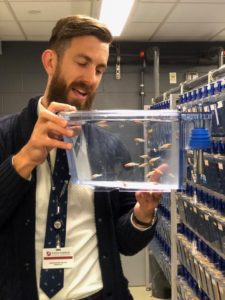
In the zebrafish lab, Dr. Kithcart uses genome editing to study cardiovascular health. Using a technology called “CRISPR,” researchers like Dr. Kithcart can change the genes of the fish so that they express different traits. CRISPR stands for “clustered regularly interspaced short palindromic repeats.” It works by targeting and editing specific pieces of DNA, which leads to changes in how genetic traits are expressed.
It all starts when the fish egg is first fertilized and exists as a single cell.
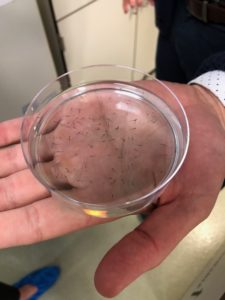
“When the egg is fertilized at the one-cell stage, we can inject something into that single cell and it will propagate into all of the cells,” explained Dr. Kithcart. “CRISPR is what I use right now. We use it to edit the genome. What that does is it goes in and targets a specific area of the DNA, manipulates it, and then that DNA change is passed along to every single cell down the line. That’s why we do it at the one-cell stage.”
By using CRISPR and other forms of genetic manipulation, the Brigham and Women’s lab has been able to create several different strands of zebrafish to help study cardiovascular health.
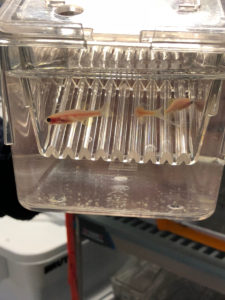
Casper zebrafish
Researchers can modify the appearance of the fish using CRISPR. One example of genetically modified zebrafish are the Casper zebrafish. The Casper fish, named after Casper the Friendly Ghost, have been manipulated and bred to be transparent. Researchers can easily observe the insides of the fish, including the cardiovascular system. “These fish in particular are useful for studying things like blood clots,” commented Dr. Kithcart. “I use these fish to look at blood clots forming because I can look right through the fish. You can look under a microscope and actually see a blood clot forming.”
Glowing zebrafish
Several strands of zebrafish in Brigham and Women’s lab have been genetically modified using transgenic manipulations to glow under the right lighting. Researchers use this lighting to observe the fish under a microscope. Two of these strands are known as IGM GFP and FlkGFP.
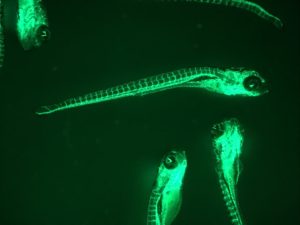
“GFP stands for green florescent protein,” explained Dr. Kithcart, addressing the IGM GFP strand. “These fish genetically express a green florescent protein on all of the cells that express IGM, which are B cells. All of the B cells in this line of fish will be green.”
B cells are a form of white blood cell that play an important role in the immune system.
“Another fish studied with GFP are FlkGFP,” he continued. “That means there’s green florescent protein expressed on all of their blood vessels. Blood vessels are, of course, very important in clot formation. I use these fish a lot to look at how clots are forming.”
High-cholesterol-diet zebrafish
In addition to genetically modifying the fish for research, researchers can change the fish’s diet and environment to study different topics. Some of the zebrafish are used to study the effects of an unhealthy diet on the cardiovascular system.
“We have fish that are being fed a high-cholesterol diet. We feed them an ‘Americanized’ diet that is about 4 percent by weight in cholesterol. It would be very similar to having a Big Mac 5-6 times a day,” said Dr. Kithcart.
“They’re much bigger,” he continued, describing the adult zebrafish who grew up on the high-cholesterol diet. “After being fed a high-cholesterol diet for a couple of years, these fish are huge. They’re unhealthy. They get atherosclerosis just like any human would who had been on that type of diet for that long. They tend to die of early disease.”
Looking forward
As research on these fish continues, they represent an endless opportunity for innovation and new discoveries. From cancer to aging, blood clots to heart attacks, these fish will help future scientists to discover new treatments and perhaps even answer some of medicine’s most pressing questions.
Thank you, zebrafish, for opening the door to discovery.



